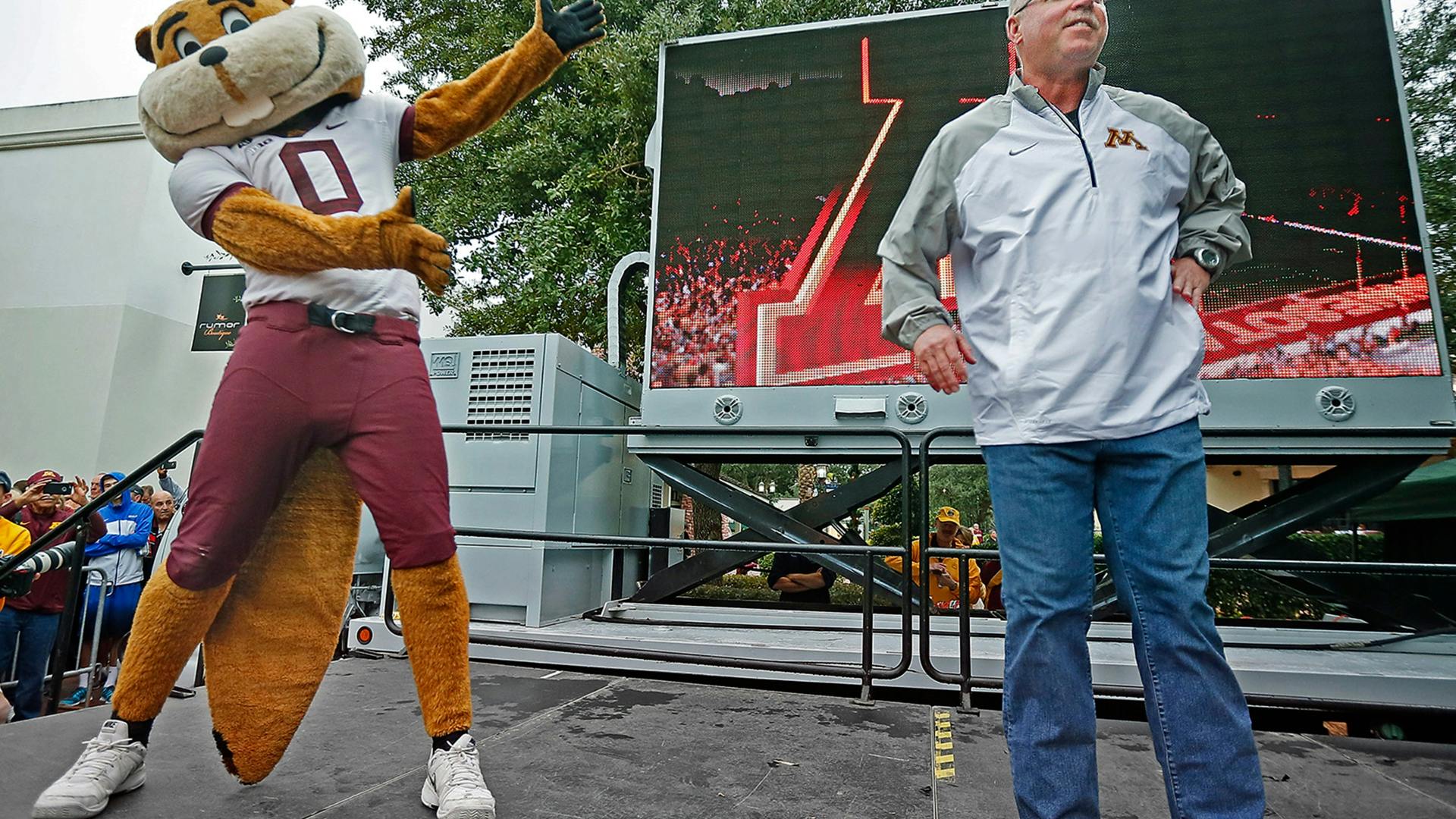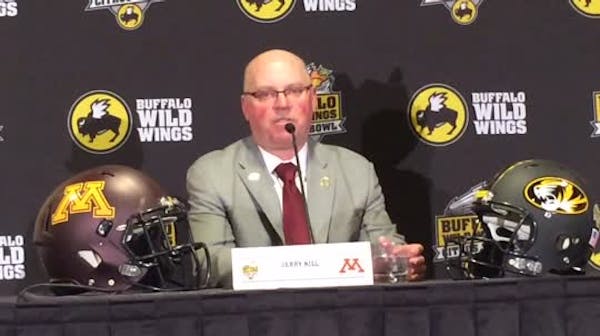ORLANDO
A football program could get used to this.
New Year's Day dawns and a fan base wakes with giddy excitement, ready to don the school colors and sing the old songs and cheer themselves hoarse in 77-degree sunshine.
It's been 53 years since the Gophers last played on Jan. 1, college football's holiday, an enormous void tracing to their 1962 Rose Bowl win over UCLA. Even though this Citrus Bowl showdown with Missouri doesn't carry that same prestige, getting here was a key step in coach Jerry Kill's rebuilding project.
The question now, of course, is whether Kill and the Gophers can take the next step, joining Wisconsin, Nebraska and Iowa as Big Ten West programs that expect to spend New Year's Day sweating in warm sunshine each year.
Is this trip to the land of theme parks a one-year fairy tale? Or is Minnesota finally built to last? Even with all the Gophers' momentum in Year 4 under Kill, there are plenty of skeptics — including the coach himself.
In a season that brought him Big Ten Coach of the Year honors, Kill admitted this level of success came quicker than he anticipated when he left Northern Illinois to take the Gophers job in December 2010.
"I was telling the administration that it's going to take seven or eight years," Kill said. "We still have a lot of work to do in a lot of areas to get where we want to be."
But isn't this pretty good already?
"You've got to do it year in and year out," Kill said. "It's really unbelievable what our kids have done because we don't have the resources some of the people that we're playing against do. We need those resources to take that next step up, and that all [affects] recruiting. You win with players."
In a preseason poll of Big Ten writers, the Gophers were picked to finish fifth in the West Division. Minnesota (8-4, 5-3 Big Ten) wound up finishing second, after losing the final game of the regular season at Wisconsin, with the division title on the line.
But this was another down year for the rest of the Big Ten. The Gophers beat three teams — Michigan, Iowa and Nebraska — that all had subpar seasons by their school's standards. Michigan and Nebraska both fired their coaches.
Looking ahead, Big Ten Network analyst Gerry DiNardo doesn't see Minnesota projecting as one of the West Division favorites next year. He thinks Minnesota has overachieved at a time when other teams in the West are underachieving.
DiNardo compared Kill's coaching job to the one James Franklin did at Vanderbilt. Franklin led the Commodores to back-to-back 9-4 seasons — in 2012 and 2013 — picking off traditional SEC powers such as Georgia, Tennessee and Florida when they were struggling. Franklin parlayed that success into a new job at Penn State, where he made $4.3 million this year as one of the eight highest-paid coaches in the country.
"If you really want to evaluate Minnesota, you must say, if all seven schools [in the division] were hitting on all cylinders, where would Minnesota be?" DiNardo said. "Facilitywise, they might be last. Personnel, you could fit them in. Coaching staff, they're as good as anybody.
"That's how you have to evaluate it. Or else you have to say, 'Nebraska's not going to get better. Wisconsin's not going to get better. Iowa's not going to get better.' That's the thing I think fans don't always understand."
DiNardo's duties bring him to each conference school twice per year, during spring and fall camp. He has watched Gophers punters blast footballs into the roof of the team's 30-year-old indoor practice facility, bringing chunks of insulation to the ground.
"Recruiting is still about choices," said DiNardo, a former head coach at Vanderbilt, LSU and Indiana. "When you look at Minnesota's facilities compared to schools that go to the Citrus Bowl or better, they don't fare very well."
Next progress: Shovels?
In July 2013, the Gophers unveiled plans to build an ambitious $190 million athletic complex that would upgrade facilities for football and basketball, along with several other sports, and revamp the nutrition, training and academic centers.
They are still in the fundraising stage, with unconfirmed estimates that they've raised about $60 million, including a $21 million donation from Land O'Lakes and another $15 million from late regent David Larson's family.
"We've really got to get our athletic village up and running and get a shovel in the ground," Gophers athletic director Norwood Teague said. "We're very behind in those areas. We cannot trust that a season like this is going to guarantee us the future."
Kill has said repeatedly that he wants to see ground broken on a new football practice facility by April, or at least by this summer. The administration has been careful not to give a specific timeline.
"You never know when something will come into play from a construction standpoint that's out of your control," Teague said. "But I'm very optimistic about it happening in the near future."
Kill sounds tired of the red tape. He wants to see action soon, and by that he means bulldozers and excavators.
"It's time for the university to say, 'Hey, look where we're at. Let's go get it,' " Kill said. "That's what Wisconsin did with Barry Alvarez. They started winning and then said, 'Hey, we're hungry for this. We want to go for the marbles.' "
Players 'want to be here'
This season, Gophers recruiting coordinator Billy Glasscock noted that 30 of the 44 players on the team's two-deep roster arrived with no other offers from a "power five" conference (Big Ten, SEC, Pac-12, Big 12, ACC).
That list includes co-captains Mitch Leidner and Cedric Thompson, and All-Big Ten selections Maxx Williams, Briean Boddy-Calhoun, Eric Murray and Zac Epping.
Kill's teams have been exceeding the recruiting rankings since his days at Northern Illinois. For what it's worth, the Gophers' 2015 recruiting class currently ranks 53rd in the country, according to Rivals.com.
The lone consensus four- or five-star recruit the Gophers have landed under Kill is Jeff Jones, the running back from Minneapolis Washburn who was recently cleared academically for spring practice. Among the highly ranked players from Minnesota who have committed elsewhere the past three years are James Onwualu (Notre Dame), Jashon Cornell (Ohio State), J.C. Hassenauer (Alabama), Frank Ragnow (Arkansas), Seth Green (Oregon) and Drayton Carlberg (Oregon).
"The recruits you bring in, they want to be here," Kill said. "I guess that's the best thing about it. When you get people who want to be here, then you've got a chance to win.
"They didn't care about anything else. They love the city. They love the school. There's so much more to sell than just [the facilities].
"But even with that, everyone gives me a hard time about, 'Well, you didn't get the five-star recruit and so forth.' Well, we're not going to beat Oregon and people like that because kids are into the visual thing."
Kill's big year
Last year, Kill's health loomed as a major question for the program. Kill, who has epilepsy, took a two-week medical leave after seizures forced him to miss the 2013 trip to Michigan. At that point, he'd missed parts of four of his first 31 games as Gophers coach because of seizures.
But Kill has been seizure-free ever since, a span of 18 games and counting. He coached six games from the press box last year before returning to the sideline for the second half of last year's Texas Bowl loss to Syracuse.
Kill, 53, said he has been getting his sleep, going on long walks each day and eating better. Questions about his health now are focused on how much better he looks and feels.
He was the lowest-paid coach in the Big Ten last season, at $1.2 million. But in February, the Gophers extended his contract through 2018, and nearly doubled his pay to an average of $2.3 million per season. The contract also ensures Kill's assistant coaching salary pool will rank among the top six schools of the Big Ten, with defensive coordinator Tracy Claeys now making $600,000 and offensive coordinator Matt Limegrover making $550,000.
The staff rewarded the university with its first five-win Big Ten season since 2003, winning the Little Brown Jug at Michigan for the first time since 2005 and winning at Nebraska for the first time since 1960.
"If anything, what this season shows is that Jerry has done an unbelievable job," Teague said. "And I don't think we'll ever be able to explain what a great job it's been because he has been able to do a lot and turn a program around that was further down than most people realize."
Citrus could be a 'brick'
The Gophers will have to reload next year after losing several impact seniors, including Thompson, Epping, Tommy Olson, David Cobb, Damien Wilson and Cameron Botticelli. There's also a strong chance Williams, an All-America tight end, will declare early for the NFL draft.
But Kill believes the future is bright. He has played nine true freshmen this year and said three or four others would be starting this bowl game if they weren't redshirting.
The 2015 Gophers are a subject for another day. For now, the team's fans are focused on the Citrus Bowl, which was formerly called the Tangerine Bowl and Capital One Bowl. It's been one of the prime Big Ten bowl destinations for years, a notch under the Rose Bowl, and for the past decade it has seemed reserved for the likes of Nebraska, Wisconsin, Michigan State, Penn State, Iowa and Michigan.
The Gophers sold 8,000 tickets through the school and expect thousands more snowbirds and others to show up, decked out in maroon and gold.
Minnesota has a six-game bowl losing streak and hasn't won in the postseason since beating Alabama in the 2004 Music City Bowl. No. 16 Missouri (10-3) won the SEC East title this year, so a victory would be "another brick" in the rebuilding project, as Kill calls it.
"We won't relent," Botticelli said. "We've invested a lot in getting here. Every opportunity that we've had has been earned the hard way."
Anze Kopitar scores in overtime, Kings beat Oilers 5-4 in Game 2 to tie series
Thunder's Holmgren bests Pelicans' Valanciunas in center matchup to help OKC take 2-0 lead
AP PHOTOS: Russian kids ride sticks with a horse's head in hobby horsing competition
Defending champion Golden Knights beat Stars 3-1 to take 2-0 series lead home to Vegas


